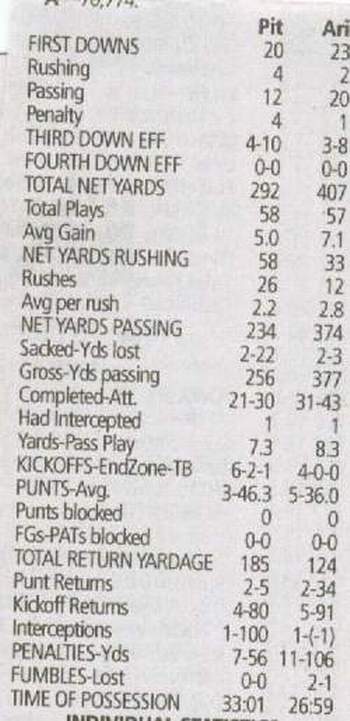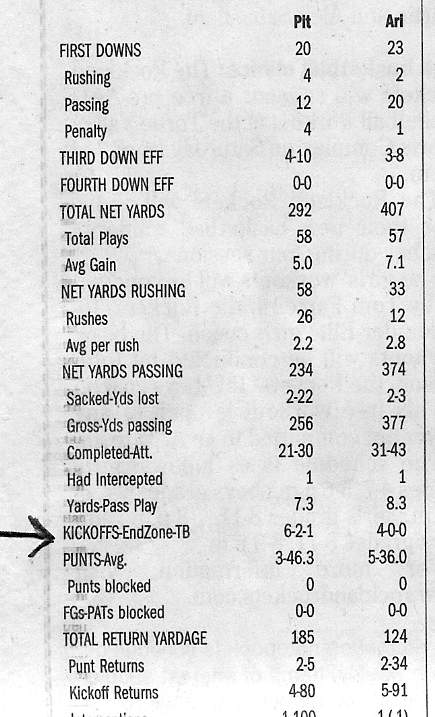On this page
Prop on Total Kickoffs in Super Bowl 43
Introduction
Every year Super Bowl sports books offer hundreds of prop bets to choose from. The vast majority of the time the winner of a prop bet is obvious. In Nevada, most sports books use the Associated Press as the ultimate source for game statistics, should there be a grey area. I think it is appropriate to use an independent source to grade such wagers. Leaving the decision to the sports books themselves can tempt the decision-maker to rule in the way that results in the greatest profit for the book maker.
In Super Bowl 43 many sports books had props on the total number of kickoffs. This was done in various ways: total number of kickoffs, which team would have more kickoffs, total kickoffs by the Steelers, and total kickoffs by the Cardinals. Some sports books had the same kind of props on kickoff returns, which is different because some kickoffs are not returned for a variety of reasons.
The following image was taken from the graded list of props at the Golden Nugget, on the total number of Steeler kickoffs. It shows there were exactly six, so the bet resulted in a push on both sides.


The Pinnacle off-shore sports book had bets on under or over 9.5 kickoffs. First they graded the under as the winner, then the over, then the under again, and finally both sides. Here is what they wrote to a player who bet the over.Please be advised that the "over-under on kick-offs" prop for the Super Bowl has resulted in some confusion. Because of the confusion regarding this issue we are grading all bets as winners.
The NFL.com sites differentiates the kick-off after a safety from regular kick-offs, describing it as a "free kick." Also, this kick can be a place-kick or a punt further differentiating it from regular kick-offs which can only be place-kicks.
There is a category on the box score which gives kick-off returns (total of 9 for this Super Bowl). Presumably for there to be a kick-off return, there must be a kick-off. Using this logic, we see that the NFL is including the kick-off return after the safety as a "kick-off return." Thus, ten kick-offs. One at the start of the first half, one at the start of the second, one after the safety, and seven after scores. One of the eight scores (6 TDs and 2 FGs) occurred at the end of the first half with no time remaining, and there was no ensuing kick-off.
I applaud Pinnacle for this decision.
There is no debate that there were four kickoffs by the Cardinals: three for each touchdown, and one for the kickoff at the start of the first half. However, there is some debate about the number of Steeler kickoffs. There was one each for two of the touchdowns, the two field goals, and the start of the second half. There was no kickoff after the second touchdown, because it happened at the end of the first half. What is subject to debate is whether or not to count the free kick after the safety.
The argument in favor of counting the free kick is that NFL.com lists a total of six kickoffs by the Steelers. Furthermore, the free kick was caught by Steve Breaston, who returned the kick for 9 yards. In the play by play, it shows Breaston caught kicks three times: a punt return for 34 yards in the second quarter, a punt return for 0 yards in the fourth quarter, and the kick return after the safety for 9 yards. The box score lists 34 punt return yards and 9 kickoff return yards for Breaston. Counting those 9 yards towards kickoff returns implies the free kick was a kickoff. Finally, in the play by play, the word "kick" is used for the free kick. The only other time "kick" is used is for kickoffs. Punts, field goals, and extra points do not use the word "kick." Using the word "kick" for both a kickoff and free kick argues that a free kick is a kickoff.
The argument against counting the free kick is that kickoffs are traditionally done with a tee. If it is windy, another player can hold the ball with a finger. However, a tee may not be used on a free kick after a safety. The NFL rules say, "On a safety kick, the team scored upon puts ball in play by a punt, dropkick, or placekick without tee." In almost every case, including this one, the punt is chosen. However, for purposes of total number of punts, it doesn't count. So, because the kickoff without tee wasn't chosen, it shouldn't count as a kickoff. Some go further to argue that even if they did choose to kickoff, because the tee would't be used, it shouldn't count as a kickoff. That begs the counter-point that hand-held kickoffs, because of high wind, are still counted as kickoffs.
The rules at NFL.com are murky about whether a free kick counts as a kickoff. On one hand, they say "In addition to a kickoff, the other free kick is a kick after a safety (safety kick)." One could interpret that as meaing that a free kick is a separate thing from a kickoff. On the other hand, the section about safety kicks is under the heading and URL address of "kickoff."
The newspapers originally reported six kickoffs by the Steelers. Here are clippings from the Las Vegas Review Journal and The Journal News (published in Rockland County, NY) box scores from February 2.
| Las Vegas Review Journal | The Journal News |
 |
 |
It is my understanding that for purposes of grading wagers, the sports books do not accept changes made after the day of the event. An example of such a change was the infamous pine tar baseball game in 1983. Even if the NFL changes the number of kickoffs, I do't think anybody in Nevada will change how they graded this prop voluntarily. However, if any bettor feels the prop was graded incorrectly, they can file a dispute with the Nevada Gaming Control Board.
If forced to a decision, I think the free kick after the safety should count as a kickoff. This seems to contradict the rules of football, but I think the way the game statistics were initially recorded by the NFL and the newspapers should supersede that. Out of tradition, changes made after the day of the game should not count.
Additional Reading
Prop Payoff Is in the Details, from the February 12, 2009, Las Vegas Sun.


